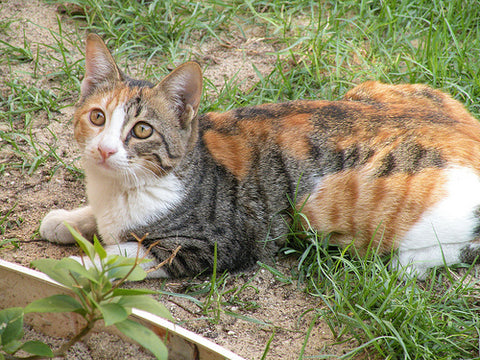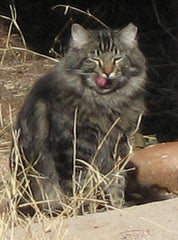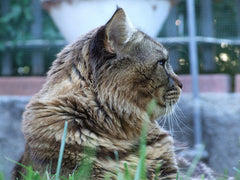
Breaking News: Shocking!
Family moves ~ leaves feline
family member to fend for herself!
Oh wouldn’t it be great if this kind of behavior were newsworthy and seen as scandalous?
What if abandoning furry family members was truly a punishable offense?
Sadly, the reason we don’t see this kind of headline is because this sort of behavior in humans is all too common.
When discarded like this, family pets have no choice but to try and make it on their own. If they do not meet an untimely end, the majorities of these pets become feral or are scooped up by animal control. Very few find themselves swept off their paws fairy-tale style and find themselves in loving new homes.
Sigh…humans have so much to learn.
National Feral Cat Day

October 16 has been declared National Feral Cat Day, so we are going to take a few moments to talk about feral cats and how we can do our best to make up for the irresponsibility of some of our fellow humans by becoming advocates for feral cats in our community. You can do the same.
Every community hays a feral cat colony or two ( or six thousand…) and together we can all take small steps to make life better for the ferals out there now, and to reduce the feral cat population.
Which came first, the feral or the stray?
Defined by the Mirriam-Webster dictionary as “having escaped from domestication and become wild”, feral does indeed mean wild in terms of behavior and socialization to humans. Feral cats are born in the wild although they are direct descendants of once domesticated cats. A stray cat is a cat who was once domesticated and has become lost or abandoned or has otherwise “strayed” from his or her human family. Strays can and do join established feral cat colonies, and if unaltered (spayed or neutered) will inevitably parent kittens. So while it is impossible to trace back to the first feral, we know that being stray is the first step.

How about those kittens?
Scary math time: Together, an un-neutered male and an un-spayed female cat can have two or more litters per year. The litters in turn can ultimately produce 420,000 offspring over a seven-year period.
Yes. Two unaltered cats can turn into 420,000 cats.
Four....Hundred...Twenty....THOUSAND.
Wow. Just…WOW.
Where do they all live?
Feral cats live in groups called colonies,or clowders. A feral cat colony can consist of anywhere from 3 to 25 cats. They live in alleys, abandoned buildings, junk yards, open fields, etc. When I lived in Long Beach CA., we had numerous feral cat colonies living in the rocks along the cliffs and at the water’s edge in the bay. The cats looked like illusive little mermaids. This was a well-managed colony but such a vast number of “beach cats” exist, it can be hard to stay on top of the spay/neuter efforts.
With ever growing expansion, feral cat colonies are being bulldozed and eliminated each day. Some colonies regroup, some disband, and some are destroyed completely. A few are relocated by volunteer groups and cat rescue organizations. While remaining outdoors is really ideal for true feral cats and every effort to manage the health and population in established colonies , some colonies are not able to be relocated safely. A few shelters and sanctuaries have allocated space for ferals to live in as much the same way they lived before being confined. Best Friends Animal Sanctuary in Utah has an excellent indoor-outdoor enclosure complete with rafters for the feral cats there to explore and to stay out of sight if they so desire.
He

alth Concerns
Since feral cats must fend for themselves, they tend to eat anything from garbage to birds, mice and small rodents. It is no wonder that so many ferals struggle with intestinal parasites. Feral cats are also at high risk of anemia due to fleas. Upper respiratory and eye infections are common as well, as their immune systems are not at optimum levels. Remember, feral cats are no different internally from the beloved family pets you know and love. They simply have not been afforded the nutritional and medical attention they have evolved to depend on, nor have they been socialized by humans to expect care and kindness.In addition to managing spay/neuter, we have some people managing feral colonies who are giving our Immune Support. This can help with weak immune systems and especially for the residents with FIV/feline herpes and chronic upper respiratory infections.
What can you do?
There are feral cat programs throughout the world, and likely right in your community. To find the feral cat program closest to you. HSUS has a listing here: (http://www.humanesociety.org/issues/feral_cats/tips/feral_cat_organizations.html)
No local programs? Not to worry. Helping feral cat populations in your community is important, and there is help and support out there for you. Several individuals and groups have set up feeding stations in order to keep an eye on resident ferals. This helps makes it easier to can keep an eye on population and health. Trapping, spay or neuter, deworming and vaccination is also much easier when an established feeding station is in place.Trapping, sterilizing and returning feral cats to their colony is a proven and effective means of controlling the feral cat population. This is referred to as TNR. Once a cat has been sterilized, most organizations do “ear tipping” under general anesthesia. Ear tipping provides immediate visual identification to alert animal control that a cat is part of a managed colony, as well to caregivers so they can know which cats have been spayed or neutered and which have not.


Cat with tipped left ear Feral cats in humane traps at a spay/neuter clinic
Up next:
Winter is approaching, and concerns about how to protect feral cat populations from the harsh elements abound. Stay tuned for tips on helping ferals in your area to stay warm, dry and well fed throughout the winter.
